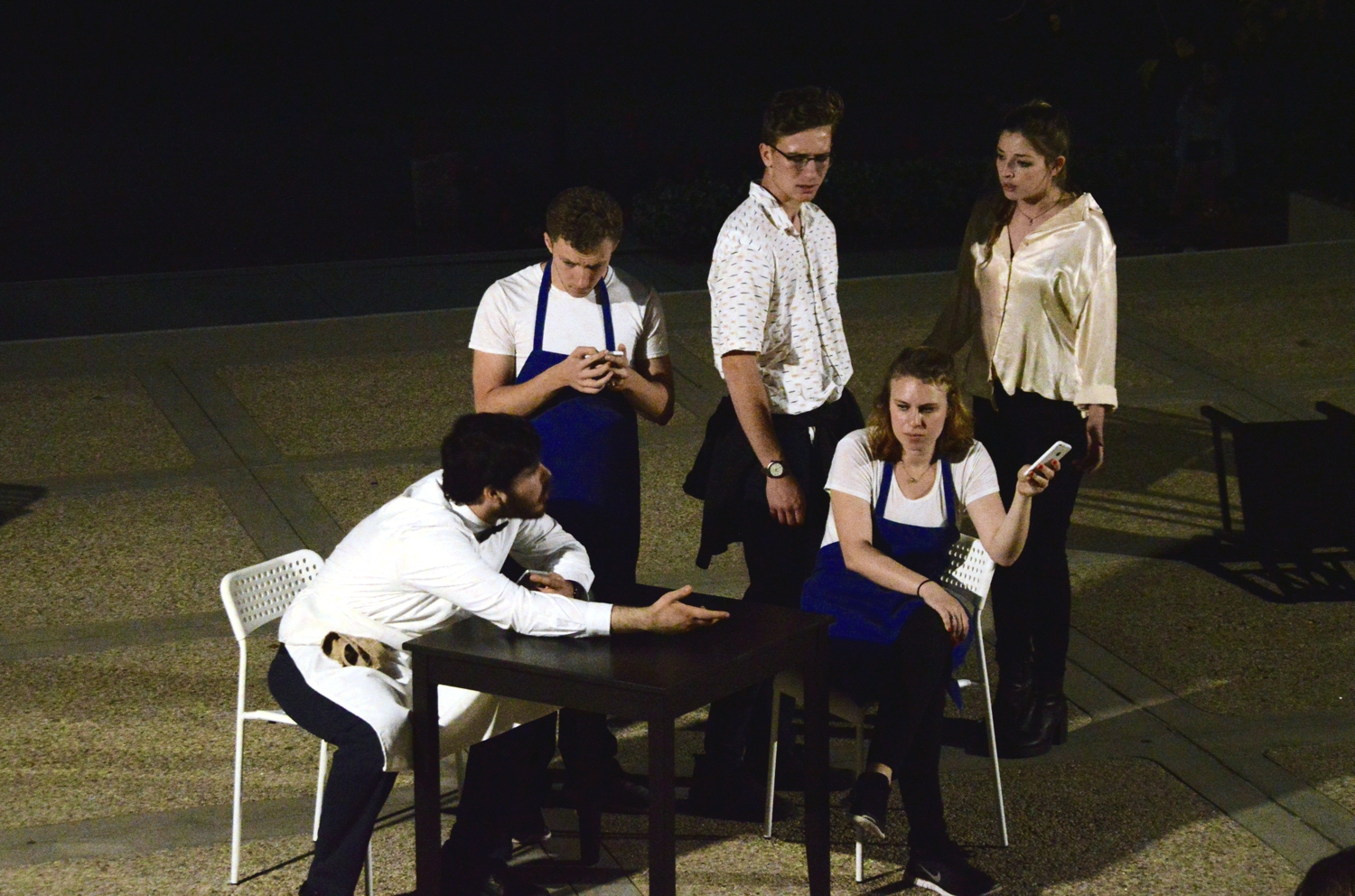Rhinos rampaged throughout Keck Theater April 28 for the opening of the Occidental theater department’s studio show “Rhinoceros” by Eugene Ionesco. Director Laurel Meade originally planned for the hour and a half long performance to unfold on the Arthur G. Coons building courtyard, but Friday’s performance was relocated due to heavy winds. Saturday and Sunday’s performances took place on the courtyard. After the performance, Paisley Dutcher (sophomore) organized a question and answer with the director, cast and approximately 40 audience members to unpack the nuances of the piece. The ensemble of 11 actors navigated Ionesco’s absurdist play where the main character, Berenger, played by Wellesley Daniels* (senior), and her friends Daisy, played by Diyoni Isom (sophomore) and Dudard, played by Kevin Bogel (senior), slowly watch everyone in their city turn into rhinoceroses. Admission was free and the performance was open to the public.
Meade adapted Derek Prouse’s translation of the French play and changed the setting from a small town in 1960s France to 2017 Los Angeles. Newspapers became smartphones and outdated cultural references were removed. Although Ionesco wrote the play in 1960, Meade chose to direct “Rhinoceros” because she found its message to still be timely. Meade explained that the play explores issues of fascism, conformity, mob mentality and power. Kobe Cancel (sophomore), who plays Johnny, was drawn to the piece for its political overtones.
“I was attracted to this show because of the show’s relevance and message. With the rise of fascism and the ‘alt-right’ across the globe, I think the story is an important one to tell,” Cancel said. “I am interested in shows that feel important for our community and our moment.”
A majority of rehearsals were spent on ensemble building and understanding the intricacies of physical theater. Each time a rhinoceros barreled through the streets outside, the actors wobbled, fell and tumbled across the stage as if the ground were actually shaking. Timed to the beat of a drum, actors would stop and hold extravagant poses such as grabbing each other’s legs as if they were going to fly away. Meade described the directing process as similar to choreographing a dance.
“It’s like staging an hour and a half long dance with 11 people talking at once,” Meade said.
With each rhinoceros transformation, the actors donned rhinoceros masks and adopted rhinoceros-like movements such as foot-stomping and arched backs. Stage manager Megan Johnson (sophomore) spent about three hours creating each mask out of paper and plastic film. Elliot Davis (sophomore), who played the Grocer Husband/Neighbor Man, emphasized that the play is not concerned with realism and exactness with their rhinoceros physicality. The actors moved how they would want to move if they were humans turned into a rhinoceroses. Davis noted that the bulky mask was not a hindrance to his physical performance.
“Even though you’re wearing a mask, you still have to be in it. You have to play through the mask and you have to project your energy out,” Davis said.
It seemed as if no two characters transformed into a rhinoceros for the same reasons. The audience only saw the entire physical transformation onstage of the character Johnny after an argument with Berenger wounded his pride. Cancel distorted his face, voice and posture and eventually “grew” a horn to signal the change.
According to Meade, the absurdist language and quick pace also challenged the cast’s memorization skills. Two separate conversations would often run onstage simultaneously, overwhelming the audience. Cancel noted that characters also do not listen to each other, especially in the opening scene — some lines were repeated multiple times and some are not meant to even make sense. Alexander Waxler (junior), who played the villainous Mr. Botard, noted that understanding the logic of his character was more difficult than memorizing the lines.
“He’s so wrapped up in ideology that he denies obvious facts, lies to cover his mistakes, denies the lies, then denies that he was ever wrong,” Waxler said. “His arguments are so circular that it rivals the difficulty of memorizing gibberish, but there’s always a weird satisfaction with being one of the most hated people on stage.”
Meade emphasized that the play’s final message and continued relevance come from the symbol of the rhinoceros.
“It’s a metaphor for people who turn monstrous regardless of their belief system at the end of the day,” Meade said.
Eleanor Goulden (sophomore) who plays the Logician/Neighbor Woman also emphasized that the rhinoceros change was individualized to each performer.
“As [the play] grew, it became more personal about what being a rhinoceros meant,” Goulden said.
“Rhinoceros” will have one final performance at at 8 p.m., May 19 in the AGC courtyard.
*Wellesley Daniels is the Senior Editor of The Occidental Weekly
![]()




































